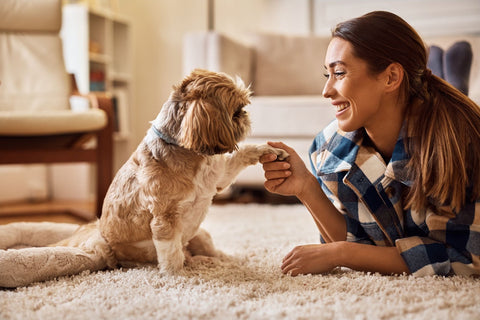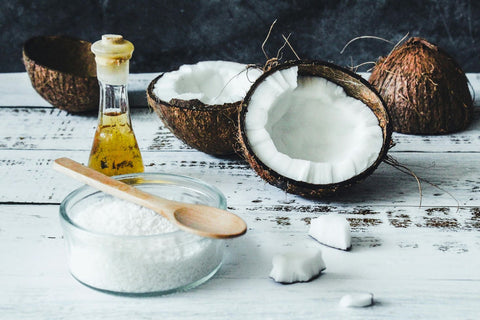Gently clean and dry your dog’s paws, then apply small amount of pet-safe balm with ingredients like shea butter or lanolin. Massage into each pad, focusing on dry areas. Use 1–3 times per week based on activity. Distract your dog to prevent licking while it absorbs.

Dog paws take a lot of wear, through hot pavement, icy sidewalks, rocky trails, and even rough indoor flooring. Their pads are built to handle pressure and friction, but they still depend on a steady level of hydration to stay healthy.
Before diving into routines and remedies, here’s a quick snapshot for pet owners looking for fast answers:
Dog Paw Moisturizing: At a Glance
-
Dry Paws Are a Warning Sign: Cracks and flakes can lead to infections, discomfort, and behavior changes.
-
Avoid Human Products: Most lotions and ointments for people can sting or harm dogs if licked.
-
Use Pet-Safe Ingredients: Look for lanolin, beeswax, shea butter, and coconut oil, proven hydrators that won’t irritate.
-
Apply Sparingly: A pea-sized amount goes a long way; too much can soften the pads too much or encourage licking.
-
Consistency Over Quantity: Moisturize based on your dog’s activity, daily for dry paws, weekly for maintenance.
-
Make Application Stress-Free: Pair moisturizing with distractions like treats or cuddle time to keep it routine.
When paws start to dry out, you might notice flaking, surface cracks, or constant licking. These issues aren’t just cosmetic. Left untreated, they can lead to pain, infections, and even changes in how your dog walks or behaves. Using the wrong product, or applying it too often, can make things worse.
Moisturizing your dog’s paws isn’t difficult, but it does require a thoughtful approach, using products made for pets and following a routine that works for both of you.
Dry, Cracked Paws Aren’t Just Ugly, They’re Dangerous
Dry paws are more than a seasonal nuisance. When a dog’s paw pads lose moisture, they become less resilient and more prone to splitting or abrasions.
What starts as a rough patch can quickly turn into an open crack that traps debris or grows bacteria.
This kind of discomfort often causes dogs to lick or chew at their paws, which introduces even more risk of irritation or infection.
Dogs with damaged paws may become hesitant to go on walks, start limping, or change how they distribute weight. These behavior shifts are sometimes mistaken for joint problems or aging when they’re actually responses to foot pain.
What Happens When You Ignore Paw Health
-
Cracks can harbor bacteria and trap dirt or allergens
-
Persistent licking may thin the skin and lead to open sores
-
Dogs with sore paws may refuse to walk or play
-
Over time, untreated damage can alter gait and posture
Everyday Culprits Behind Dry Paws
Environmental and lifestyle factors often contribute to dryness.
Many owners don’t realize that even clean, indoor living can dry out pads if the air is too dry or surfaces are abrasive. Outdoor conditions add another layer of stress.
Conditions that commonly lead to dryness or cracking:
-
Hot pavement during spring and summer walks
-
Road salt and ice melt chemicals during winter
-
Frequent washing with drying shampoos or soaps
-
Exposure to sand, gravel, or hiking trails
-
Low humidity indoors during colder months
-
Allergic reactions to grass, pollen, or floor cleaners
-
Lack of internal hydration from limited water intake
Regular inspection and the right moisturizing routine can stop these issues before they escalate.
That means spotting early signs, knowing what contributes to dryness, and applying moisture that actually helps.
Why Human Moisturizers and Quick Hacks Often Make Things Worse
Moisturizing a dog’s paws seems simple until you look closely at the ingredients.
Many people reach for whatever is already in the bathroom cabinet, not realizing that most human products are not formulated for animal skin. Human lotions often contain alcohols and synthetic fragrances that can sting or irritate a dog’s paw pads.
Even natural products made for people may have an unsuitable pH balance or oils that are harmful if licked.
Petroleum jelly is another common go-to, but it tends to create a greasy layer that traps dirt and dust.
It does not absorb well into paw tissue, and because it sits on the surface, it can lead to more licking, not less. Once it starts to collect debris, it can do more harm than good.
Even products made for dogs can cause issues when overused. Excessive application of balm, especially daily, can soften the paw pads to the point that they lose some of their natural toughness.
Dogs who walk on gravel or rough surfaces may become more vulnerable to cuts or bruising.
Moisture needs to be restored in moderation and with the right balance of absorption and barrier support. Choosing wisely protects more than just the skin.
Proven, Dog-Safe Ingredients That Actually Work
When choosing a paw moisturizer for your dog, the ingredient list matters more than the packaging or scent. Dogs often lick their paws after application, so every component needs to be safe if ingested and beneficial when absorbed.
The best formulas rely on natural substances that hydrate, heal, and protect without creating residue or softening the pads too much. Here are some of the most effective ingredients used in high-quality, dog-safe moisturizers.
Lanolin
Lanolin is a natural wax derived from wool that creates a moisture seal while allowing skin to breathe. It hydrates without clogging pores and has a consistency that absorbs well into thicker tissue like paw pads.
Lanolin is especially helpful for deep dryness or exposure to extreme weather. Unlike petroleum-based products, it does not trap debris and holds up well during daily activity.
Because it seals without making paws slippery, it works well for dogs who spend time outdoors or on mixed terrain.
Beeswax
Beeswax forms a breathable shield over the skin that locks in moisture and protects against environmental stress. It is particularly useful during winter when snow, ice melt, and road salt can break down the surface of the paw pads.
Beeswax also helps during summer walks when pavement can become hot and abrasive. It adds structure to balms, giving them a solid consistency that stays in place longer than oils. This helps reduce licking and allows for better absorption.
Shea Butter
Shea butter offers deep hydration and a soothing effect, especially for cracked or flaky skin.
It softens rough patches without breaking down the protective texture of the paw pad. In dogs with mild irritation, shea butter helps restore moisture while calming redness. It is often used as a base in paw balms because it melts at body temperature and spreads easily into skin.
High-quality shea butter is also rich in fatty acids and vitamins that support recovery and resilience.
Coconut Oil
Coconut oil is widely known for its moisturizing properties and is safe to ingest in small amounts. It can be used on dry, irritated paws and is particularly helpful when applied sparingly to rough areas.
While it does not offer the same barrier strength as wax-based ingredients, it works well in combination with beeswax or shea butter. Some dogs may find the scent or taste appealing, so it is best used in small amounts or before sleep when licking is less likely.
For dogs with sensitive skin, unrefined coconut oil provides a gentle, natural solution.
Calendula and Neem Oil
Both calendula and neem oil offer antimicrobial and anti-inflammatory benefits, making them ideal for dogs prone to irritation or minor infections.
Calendula is known for its ability to soothe raw or itchy skin, while neem oil adds an extra layer of protection against fungal or bacterial growth.
When blended into paw balms, these ingredients do more than moisturize. They support healing in paws that have already started to crack or become inflamed. This makes them especially useful during seasonal changes or after exposure to allergens.
Vitamin E (Pet-Formulated)
Vitamin E helps repair damaged skin and supports the natural regeneration of cells.
When used in pet-formulated creams, it targets cracks, dryness, and minor abrasions without disrupting the paw’s natural function. It also enhances the performance of other ingredients by increasing moisture retention and supporting elasticity.
Dogs with visible flaking or light bleeding benefit from the addition of vitamin E in their care routine.
Always ensure the product is labeled for animal use, as human formulations may include added ingredients that are not safe for dogs.
How to Apply Moisturizer Without Turning It Into a Wrestling Match
Getting moisturizer onto your dog’s paws should not feel like a battle. The key is keeping the process short, consistent, and distraction-friendly.
Dogs are more likely to tolerate the routine if it happens quickly and predictably.
Using the right amount of product also makes a difference. Too much balm can feel greasy and may encourage licking, while too little will not be effective. With a little practice, the whole thing takes less than five minutes.
Here is a step-by-step approach that works for most dogs:
-
Step 1: Rinse your dog’s paws with warm water to remove dirt or salt. Use goat milk soap if the paws are especially dirty or exposed to chemicals.
-
Step 2: Dry the paws thoroughly with a clean towel. Pay attention to the spaces between the toes where moisture can linger.
-
Step 3: Apply a small amount of paw balm to each paw. Too much can lead to slipping or licking.
-
Step 4: Massage the balm into each pad and the surrounding creases using gentle pressure. This also helps with circulation.
-
Step 5: Distract your dog for three to five minutes with a chew toy, treat puzzle, or mealtime. This helps the balm absorb before it gets licked off.
Timing Matters: How Often Should You Moisturize?
How often you moisturize your dog’s paws depends on their activity level, the environment they live in, and whether you are treating an issue or maintaining healthy skin. Too much moisture can soften the pads too much, while too little allows dryness to return.
Finding the right rhythm keeps paws protected without overdoing it.
-
Daily: Moisturize once a day if your dog has visibly dry, cracked, or irritated paws. This is also recommended during cold months when exposure to snow, salt, or dry indoor air is high.
Dogs recovering from rough terrain or long hikes may also benefit from daily use for a few days until their paws return to normal.
-
Two to three times per week: If your dog goes on regular walks through mixed environments like pavement, grass, or sand, this routine helps keep the paw pads balanced.
It provides moisture without softening the paws too much, which is especially helpful for dogs that are active but not currently experiencing dryness.
-
Once a week or less: For indoor dogs or those with limited outdoor exposure, weekly moisturizing is usually enough. This keeps the skin conditioned without disrupting the natural texture of the pads. Use visual cues like flaking or light discoloration to decide when to apply.
Paws Down, This is the Better Way
Once you understand what causes dryness and which ingredients actually help, the process becomes easy to manage and even easier to maintain.
Skipping paw care might not seem like a big deal until discomfort sets in. By then, it often takes longer to reverse the damage. A steady routine with safe, proven products protects your dog’s paws before problems begin.
You already pay attention to what goes into your dog’s bowl. What you put on their skin deserves the same kind of vigilance.
Explore the Pet Care Collection at Legend’s Creek Farm to find everything your dog needs to stay in perfect condition no matter the season or his age.





